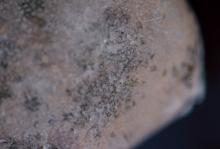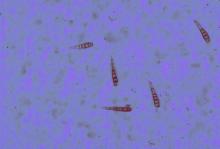By P. B. Hamm and C. M. Ocamb
Cause A fungus, Helminthosporium solani, which is spread primarily by infected seed but can survive a short time on potato debris in soil. The disease can worsen in storage, beginning 3 to 4 months following storage, and ultimately result in substantial infection with longer storage. High humidity above 90% favors this disease. Smooth skin varieties, particularly when grown in cooler soils with higher consistent soil moisture, may be severely infected at harvest. Russet varieties are apparently not as susceptible. This disease is only a surface problem but nevertheless can cause substantial losses by disfiguring the tuber surface. Can occur with other tuber blemish diseases such as black scurf or black dot
Symptoms Small, light brown circular spots that tend to grow together and cover large areas of tubers. Sometimes scurf is an olive color. When lesions are wet, they take on a silvery color that gives the disease its name. Symptoms frequently are found on or near the tuber's stem end. May be confused with black dot.
Cultural control
- The use of pathogen-free seed is extremely important.
- Harvest tubers soon after they mature.
- Dry tubers with nonhumidified air when they enter storage.
- Storage below 40°F slows disease development but may lower quality of processing potatoes.
- Russet-skinned varieties are damaged less than red or white varieties.
- Rotate out of potatoes at least three years before replanting to potatoes.
- Completely remove all tubers from storage once removal has begun. Activity in a storage bay spreads spores and will cause additional infection if the rest of the tubers are left for an extended time.
Chemical control
- Dithane DF Rainshield (Group M3) at 1.25 lb/50 gal water used as a soak for seed piece decay
- Dynasty (Group 11) at 0.1 to 3.75 fl oz/100 lb seed plus a dye. 4-hr reentry.
- Elatus (Group 11 + 7) at 0.34 to 0.5 oz/1,000 row feet applied in a 7-inches or less band either in-furrow at planting. Preharvest interval is 14 days. 12-hr reentry.
- Evito 480 SC (Group 11) at 0.16 to 0.24 fl oz/1,000 row feet. Preharvest interval is 7 days. 12-hr reentry.
- Evolve Potato Seed Piece Treatment (Group 1 + 27 + M3) at 0.75 lb/100 lb seed pieces.
- Maxim MZ (Group 12) at 0.5 lb/100 lb seed pieces or Maxim 4FS at 0.08 to 0.16 oz/100 lb seed pieces. 12-hr reentry for Maxim 4FS; 24-hr reentry for Maxim MZ.
- Quadris Flowable (Group 11) at 0.4 to 0.8 fl oz/1,000 row feet applied in a 7-inch or less band either in-furrow at planting or as a directed spray at cultivation. 4-hr reentry.
Biological control
- Bio-Save 10 LP is registered for control of silver scurf, research in Montana and Idaho has shown this product to substantially reduce losses. Store product under refrigeration or in the freezer until used. Add 250 g of Bio-Save 10 LP to 15 gal of non-chlorinated water to treat 1,500 sacks (100 lb apiece).
References Jacobsen, B. 1999. Montana Crop Health Report, Montana State University Extension Service Vol. 12, No. 8.
Strand, L. 2006. Integrated Pest Management for Potatoes in the Western United States, 2nd edition. UC Agriculture and Natural Resources Publication 3316. 167 pp.




